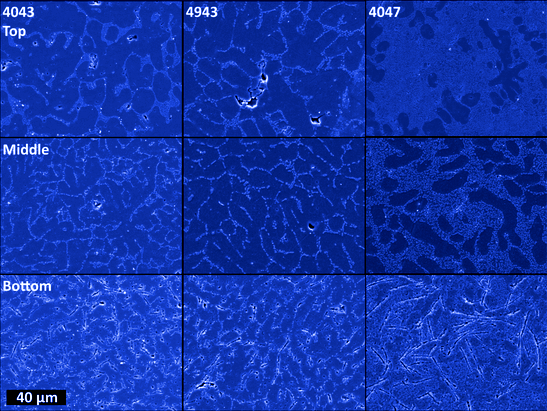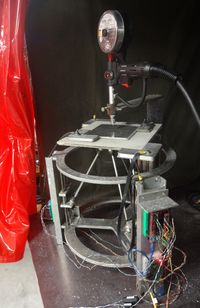J.M.Pearce (talk | contribs) m (→See Also) |
J.M.Pearce (talk | contribs) m (→Source) |
||
| Line 5: | Line 5: | ||
==Source== | ==Source== | ||
* Amberlee S. Haselhuhn, Michael W. Buhr, Bas Wijnen, Paul G. Sanders, Joshua M. Pearce, [http://dx.doi.org/10.1016/j.msea.2016.07.099 Structure-Property Relationships of Common Aluminum Weld Alloys Utilized as Feedstock for GMAW-based 3-D Metal Printing]. ''Materials Science and Engineering: A'', doi | * Amberlee S. Haselhuhn, Michael W. Buhr, Bas Wijnen, Paul G. Sanders, Joshua M. Pearce, [http://dx.doi.org/10.1016/j.msea.2016.07.099 Structure-Property Relationships of Common Aluminum Weld Alloys Utilized as Feedstock for GMAW-based 3-D Metal Printing]. ''Materials Science and Engineering: A'', '''673''', pp. 511–523 (2016). DOI: http://dx.doi.org/10.1016/j.msea.2016.07.099 [https://www.academia.edu/27308268/Structure-Property_Relationships_of_Common_Aluminum_Weld_Alloys_Utilized_as_Feedstock_for_GMAW-based_3-D_Metal_Printing open access] | ||
==Abstract== | ==Abstract== | ||
Revision as of 16:21, 3 August 2016
Source
- Amberlee S. Haselhuhn, Michael W. Buhr, Bas Wijnen, Paul G. Sanders, Joshua M. Pearce, Structure-Property Relationships of Common Aluminum Weld Alloys Utilized as Feedstock for GMAW-based 3-D Metal Printing. Materials Science and Engineering: A, 673, pp. 511–523 (2016). DOI: http://dx.doi.org/10.1016/j.msea.2016.07.099 open access
Abstract

The relationship between microstructure and properties is not widely assessed in parts produced by additive manufacturing, particularly for aluminum. These relationships can be used by engineers to develop new materials, additive processes, and additively manufactured parts for a variety of applications. Thus, the tensile, compressive, and microstructural properties of common aluminum weld filler alloys (ER1100, ER4043, ER4943, ER4047, and ER5356) were evaluated following gas metal arc weld (GMAW)-based metal 3-D printing to identify optimal alloy systems for this type of additive manufacturing. The porosities in all test specimens were found to be less than 2%, with interdendritic shrinkage in 4000 series alloys vs. intergranular shrinkage in 5356. The 4000 series alloys performed better than 1100 and 5356 with respect to printed bead width, porosity, strength, and defect sensitivity. In comparison to standard wrought and weld alloys, the 3-D printed specimens exhibited similar or superior mechanical properties with only minor exceptions. Long print times allow for stress relieving and annealing that improved the print properties of the 4000 series and 5356 alloys. Overall the GMAW-based 3-D parts printed from aluminum alloys exhibited similar mechanical properties to those fabricated using more conventional processing techniques.
Keywords
3-D printing; additive manufacturing; aluminum; mechanical properties; tensile test; compression test
Free metal 3-D printer plans

- Open-source metal 3-D printer
- MOST open-source metal 3-D printer v2
- Low-cost Open-Source Voltage and Current Monitor for Gas Metal Arc Weld 3-D Printing
- Integrated Voltage—Current Monitoring and Control of Gas Metal Arc Weld Magnetic Ball-Jointed Open Source 3-D Printer
How to get your print off the substrate with a hammer
- In Situ Formation of Substrate Release Mechanisms for Gas Metal Arc Weld Metal 3-D Printing
- Substrate Release Mechanisms for Gas Metal Arc Weld 3D Aluminum Metal Printing -
- Aluminum substrate cleaning for 3-D printing:MOST
See Also
- 3D Metal Printing Slicer Plugin
- Open-source Lab
- Open source 3-D printing of OSAT
- Life-cycle economic analysis of distributed manufacturing with open-source 3-D printers
- Environmental impacts of distributed manufacturing from 3-D printing of polymer components and products
- Building research equipment with free, open-source hardware
- Delft University of Technology - MIG+ Prusa I3
- Weld 3D - 1st commercial spin off
- see literature on "wire arc additive manufacturing" (WAAM)





